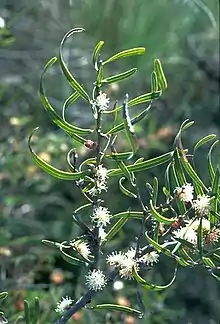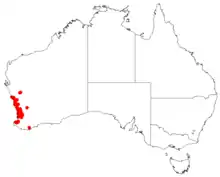| Narrow-fruited hakea | |
|---|---|
 | |
| Hakea stenocarpa in the ANBG | |
| Scientific classification | |
| Kingdom: | Plantae |
| Clade: | Tracheophytes |
| Clade: | Angiosperms |
| Clade: | Eudicots |
| Order: | Proteales |
| Family: | Proteaceae |
| Genus: | Hakea |
| Species: | H. stenocarpa |
| Binomial name | |
| Hakea stenocarpa | |
 | |
| Occurrence data from Australasian Virtual Herbarium | |
Hakea stenocarpa is a shrub in the family Proteaceae, commonly known as narrow-fruited hakea.[2] It has scented creamy-white flowers in clusters, often with curling leaves and is endemic to an area in the Mid West, western Wheatbelt, Peel and the South West regions of Western Australia.
Description
Hakea stenocarpa is a small, rounded multi-stemmed shrub typically grows to 0.3 to 1 metre (1 to 3 ft) high and forms a lignotuber. The branchlets are more or less smooth at flowering time. The inflorescence is a single raceme of 14-20 sweetly scented white, creamy-white or yellow flowers in leaf axils in the upper branchlets. The smooth pedicels are cream-white, the perianth cream-white and the pistil 4.4–5 mm (0.17–0.20 in) long. The linear leaves are 6–11 cm (2–4 in) long and 2–7 mm (0.08–0.3 in) wide with a prominent pale yellow longitudinal mid-vein. The leaves generally curl in an upward spiral. Unlike most species of hakea the fruit are long, narrow-ovoid, 2.8–3 cm (1.1–1.2 in) long and 0.6–0.8 cm (0.24–0.31 in) wide, tapering to a pointed beak. The fruit are rough and warty where they attach to the branches.[2][3]
Taxonomy and naming
Hakea stenocarpa was first formally described by Robert Brown in 1830 and published the description in Supplementum primum prodromi florae Novae Hollandiae.[4][5] The specific epithet is derived from the ancient Greek stenos (στενός), "narrow" and karpos (καρπός), "fruit",[6][7] referring to the shape of the fruit.[2]
Distribution and habitat
Narrow-fruited hakea grows in heath, low open shrubland and woodland in deep sand, loam, clay and gravel sometimes over laterite. Requires a well-drained site in sun or partial shade. An ornamental shrub, may be used as a groundcover.[2]
Conservation status
Hakea stenocarpa is classified as "not threatened" by the Western Australian Government Department of Parks and Wildlife.[3]
References
- ↑ "Hakea stenocarpa". Australian Plant Census. Retrieved 27 August 2019.
- 1 2 3 4 Young, J A. Hakeas of Western Australia:A Field and Identification Guide. J A Young. ISBN 0-9585778-2-X.
- 1 2 "Hakea stenocarpa". FloraBase. Western Australian Government. Retrieved 27 August 2019.
- ↑ "Hakea stenocarpa". Australian Plant Name Index. Retrieved 27 August 2019.
- ↑ "Hakea stenocarpa". Biodiversity Heritage Library. Retrieved 27 August 2019.
- ↑ Francis Aubie Sharr (2019). Western Australian Plant Names and their Meanings. Kardinya, Western Australia: Four Gables Press. p. 313. ISBN 9780958034180.
- ↑ Backer, C.A. (1936). Verklarend woordenboek der wetenschappelijke namen van de in Nederland en Nederlandsch-Indië in het wild groeiende en in tuinen en parken gekweekte varens en hoogere planten (Edition Nicoline van der Sijs).